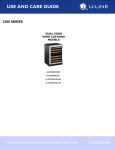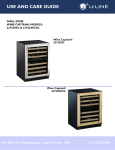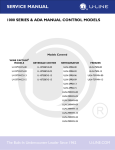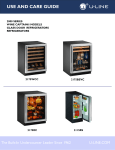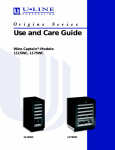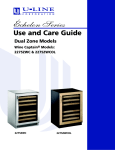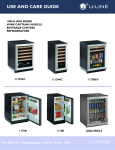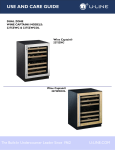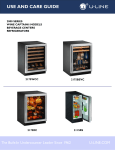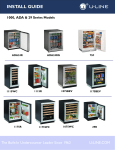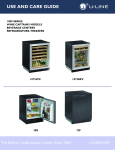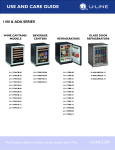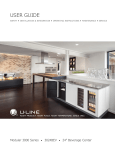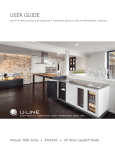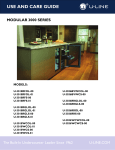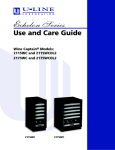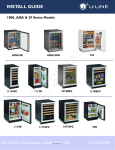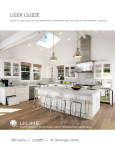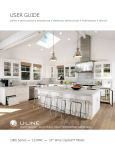Download U-Line 75 SERIES Troubleshooting guide
Transcript
USE AND CARE GUIDE ® 1000, 29 & 75 SERIES WINE CAPTAIN® MODELS BEVERAGE CENTERS REFRIGERATORS, FREEZERS WINE CAPTAIN® MODELS BEVERAGE CENTER REFRIGERATOR FREEZER U-1075WCS-00 U-1075BEVS-00 ULN-29RB-00 ULN-75FB-00 U-1075WCS-02 U-1075BEVS-02 ULN-29RB-02 ULN-75FB-13 U-1075WCS-13 U-1075BEVS-13 ULN-29RB-06 ULN-75FWH-00 U-1075WCS-15 U-1075BEVS-15 ULN-29RB-09 ULN-75FWH-02 ULN-29RB-13 ULN-75FWH-13 ULN-29RB-15 ULN-29RWH-00 ULN-29RWH-02 ULN-29RWH-06 ULN-29RWH-09 ULN-29RWH-13 ULN-29RWH-15 ULN-29RWH-23 ULN-29RWH-25 The American Built-In Undercounter Leader Since 1962 U-LINE.COM Please Record Your Model Information Congratulations on your purchase of a U-Line refrigerator. For nearly five decades and three generations, U-Line continues to be the leader in innovation, quality and value in the premium built-in undercounter ice making, refrigeration and wine preservation market. U-Line has captivated those with an appreciation for the finer things with exceptional functionality, style, inspired innovation and attention to even the smallest details. We are known and respected for our unwavering dedication to product design, quality and selection. In 1962, Henry Uihlein founded U-Line Corporation as an outgrowth of Ben-Hur Freezer Company and was the first to develop and patent an automatic stand-alone undercounter residential ice maker. His foresight and determination to develop new ideas and to succeed when there were no clear guidelines or solutions are evident today. The newest Uihlein generation continues to build upon the family’s innovative legacy at the Milwaukee, Wisconsin based business by providing continuity and vision from which new designs and technology continue to be born. You will need your product model and serial number when you request additional information or services. You can find this information on the serial plate located on the upper right or back wall in the interior of your product. This information also appears on the warranty registration card. Please complete and mail your warranty registration card. You may also register online at www.u-line.com FOR PRODUCT ASSISTANCE, CALL 1-800-779-2547 www.u-line.com MILWAUKEE, WI U.S.A. 1 HIGH SIDE DESIGN PRESSURE 300 PSI C LOW SIDE DESIGN PRESSURE 140 PSI Model/Modele: UL R US HOUSEHOLD REFRIGERATOR AND/ OR FREEZER LISTED 674R Serial/Serie: 2 BTL Introduction Please record the model number (1), serial number (2), date of purchase, and dealer contact information for your U-Line product below: Model Number: Today the complete U-Line product collection includes Ice Makers, Wine Captain® Models, Combo® Models, a Refrigerator / Freezer, Refrigerators, Drawers and Beverage Centers. The U-Line brand offers products in the 1000 Series, 2000 Series and the Modular 3000 Series. The 1000 Series offers a more targeted priced product with appropriate features, while the 2000 Series offers upscale features, advanced technology and specialized product families. U-Line’s approach to its breadth of products, multiple price points and features allows a choice and product that will fit any lifestyle. ________________________________________________ Read and save this Use and Care Guide. Dealer Name: NOTICE Serial Number: ________________________________________________ Purchase Date: ________________________________________________ ________________________________________________ READ all instructions in this guide completely before using the appliance for the first time. Dealer Address: For future reference, keep this guide in a safe, accessible location. If you need additional information or assistance, please contact ULine Corporation direct. Contact information appears on the back cover of this guide. Before Calling Service. If you think your U-Line product is malfunctioning, read the OPERATION section of this guide to understand clearly the function of the control. If the problem persists, read the TROUBLESHOOTING GUIDE section of this guide to help you quickly identify common problems, and provide information on possible causes and remedies. ________________________________________________ Dealer Telephone: ________________________________________________ u-line.com Table of Contents Safety Precautions Safety Alert Definitions ........................................................................................................................................1 General Precautions .............................................................................................................................................1 1000 Series Product Features All 1000 Series Models Feature: ........................................................................................................................2 Wine Captain® Model and Beverage Center Features: ..............................................................................2 Wine Captain® Model Features: .......................................................................................................................2 Beverage Center Features: .................................................................................................................................2 Refrigerator and Freezer Features: ...................................................................................................................2 Product Operation Air Flow ...................................................................................................................................................................3 Initial Startup ..........................................................................................................................................................3 Control Dial ...........................................................................................................................................................3 Adjusting Air Temperature .................................................................................................................................4 Interior Lighting .....................................................................................................................................................4 Checking Product Temperature ........................................................................................................................4 U-Line Wine Guide Looking Behind the Label ....................................................................................................................................5 Wine Selections Suggestions ..............................................................................................................................5 Ideal Wine Storage Considerations ..................................................................................................................6 Wine Stocking Recommendation ......................................................................................................................7 Wine Rack Removal and Installation ................................................................................................................7 Wood Trim Finishing ...........................................................................................................................................8 Maintenance Light Bulb Replacement .......................................................................................................................................9 Leveling ....................................................................................................................................................................9 Removing and Installing Interior Shelves .........................................................................................................9 Removing and Installing Door Shelves .......................................................................................................... 10 Removing and Installing Grille ......................................................................................................................... 10 Standard Doors Door Alignment and Adjustment ................................................................................................................... 11 Door Reversability ............................................................................................................................................. 11 Reversing the Door ........................................................................................................................................... 11 Cleaning Exterior Cleaning ............................................................................................................................................... 13 Interior Cleaning ................................................................................................................................................ 13 Defrosting ............................................................................................................................................................ 13 Condenser Cleaning .......................................................................................................................................... 14 Storage, Vacation and Moving ......................................................................................................................... 14 Product Disposal ................................................................................................................................................ 14 Service Before Calling for Service ................................................................................................................................ 15 If Service is Required ......................................................................................................................................... 15 Replacement Parts ............................................................................................................................................. 15 Normal Operating Sounds ............................................................................................................................... 15 Troubleshooting Guide ..................................................................................................................................... 15 General Precautions Safety Precautions Use this appliance for its intended purpose only. Follow these general precautions with those listed throughout this guide: NOTICE • PLEASE READ all instructions before installing, operating, or servicing the appliance. • Proper installation procedures must be followed when completing an installation or relocation of a unit. An INSTALLATION GUIDE for the unit, providing complete installation information, is available from U-Line Corporation direct. Consult the installation guide before any installation begins. U-Line contact information appears on the rear cover of this guide. • This unit requires connection to a dedicated 15 Amp grounded (three-prong), polarized receptacle, installed by a qualified electrician, compliant with applicable electrical codes. Safety Alert Definitions Throughout this guide are safety items labeled with a Danger, Warning or Caution based on the risk type: ! DANGER RISK OF CHILD ENTRAPMENT. Before you throw away your old refrigerator or freezer, take off the doors and leave shelves in place so children may not easily climb inside. ! WARNING SHOCK HAZARD - Electrical Grounding Required. • Never attempt to repair or perform maintenance on the unit until the electricity has been disconnected. • Never remove the round grounding prong from the plug and never use a two-prong grounding adapter. • Altering, cutting of power cord, removal of power cord, removal of power plug, or direct wiring can cause serious injury, fire and or loss of property and or life, and will void the warranty. • Never use an extension cord to connect power to the unit. • Always keep your working area dry. ! DANGER Danger means that failure to follow this safety statement will result in severe personal injury or death. ! WARNING Install provided Anti-Tip kit. Serious personal injury could occur. ! WARNING ! CAUTION Warning means that failure to follow this safety statement could result in serious personal injury or death. ! CAUTION Caution means that failure to follow this safety statement may result in minor or moderate personal injury, property or equipment damage. • Use care when moving and handling the unit. Use gloves to prevent personal injury from sharp edges. • If your model requires defrosting, DO NOT use an ice pick or other sharp instrument to help speed up defrosting. These instruments can puncture the inner lining or damage the cooling unit. DO NOT use any type of heater to defrost. Using a heater to speed up defrosting can cause personal injury and damage to the inner lining. NOTICE • Do not lift unit by door handle. • Never install or operate the unit behind closed doors. Be sure front grille is free of obstruction. Obstructing free airflow can cause the unit to malfunction and will void the warranty. • Failure to clean the condenser every six months can cause the unit to malfunction. This could void the warranty. • Do not Block any internal Fans. Use only genuine U-Line replacement parts. Imitation parts can damage the unit, affect its operation or performance and may void the warranty. u-line.com 1 Wine Captain® Model Features: 1000 Series Product Features Capacity. 24" Wine Captain Model up to 48 Bottles. Triple temperature zones. Maintains wine at their proper serving temperature. Top Approximately 55°F (Red). Middle Approximately 50°F (White). Bottom Approximately 45°F (Sparkling). Safely stores one, two or three types of wine. All 1000 Series Models Feature: Mechanical Temperature Control. Provides ability to set the temperature. Vinyl-clad cabinet. Textured, rich appearance. More resistant to scratching, peeling and flaking. Integrated handle. Does not add depth to the cabinet when built in. Black and white models only. Field-reversible doors. Flexible installation options. All models with black and white doors are field-reversible. Stainless steel models with glass doors are field-reversible. Stainless steel models with solid doors must be order right- or left-hand hinged. Adjustable leveling legs. Achieve a more precise under counter fit. Durable, strong legs will not bend when unit is installed. Defrost Type: Automatic (cycle) Defrost. For indoor use only. 3/4 extension slide-out coated wine racks. Allow for easy access to all wine bottles. Four or eight wine bottle capacity (0.75 L) on each rack. Stable temperatures. Stable, consistent temperatures provide longer-term storage capability. Built-in. Provides custom look. No additional clearance required around sides, top or rear of unit for ventilation. Do not obstruct front grille. Beverage Center Features: Capacity. 24" Beverage Center 5.6 cubic feet Dual temperature zones. Maintain two distinct temperature zones. Cooler at the top of the cabinet for storage of fine wines and coldest at the bottom to store your favorite beverages. Two full-size, removable glass shelves. Generous storage area for beverages. Wine Captain® Model and Beverage Center Features: 3/4 extension slide-out coated wine racks. Allow for easy access to beverages. Low-E coated, gas filled thermal glass door. Allows for effective product presentation. Protects wine and other products from potentially harmful ultraviolet light rays. Built-in or freestanding. Provides custom look when built-in with no additional venting clearance required on sides, top or rear. Do not obstruct the grille. Wood trimmed wine racks. Wood can be stained or replaced with a solid surface material to match surrounding décor. Refrigerator and Freezer Features: Stainless steel model. Offers a bold stainless steel handle, stainless steel wrap door with black "cap" on top and bottom of the door. Capacity. 29 Model Refrigerator Capacity 3.3 cubic feet. 75F Model Freezer 5.22 cubic feet. Flat recessed grille. Blends with the other models and integrates with surrounding cabinetry. Recessed interior light. Automatically illuminates when door is opened. Does not interfere with product access or storage. Adjustable tempered glass shelves. Sleek, streamlined interior. Allows flexible shelf locations to meet varying food and beverage storage needs. Three in Refrigerator, four in freezer. Two adjustable in-door storage shelves. Easy access storage area, right where you need it. Adjustable to allow flexible storage options. Door will accept a 1/4" panel. Ability to match surrounding décor and cabinets. Black and white models only. Built-in or freestanding. Provides custom look when built-in No additional venting required on sides, top or rear. Do not obstruct the grille. Flat recessed grille on Refrigerator. Blends with the other models and integrates with surrounding cabinetry. Model 29 Refrigerator is Energy Star qualified. Saves energy, saves money, saves our natural resources. All features and specifications are subject to change. 2 u-line.com Initial Startup Product Operation All U-Line controls are preset at the factory. Initial startup requires no adjustments. Air Flow NOTICE NOTICE The unit requires proper air flow to perform at its highest efficiency. Do not block the front grille or internal fans at any time, or the unit will not perform as expected. Do not install the unit behind a door. U-Line recommends allowing the unit to run overnight before loading refrigerator or freezer with product. To turn the unit on: Turn the control dial found in the center of the grille to a MID setting, number 3 or 4 on the controller knob. To turn the unit off, turn the control dial counterclockwise until hearing a “click”. It may take some force to get the control to “click”. Control Dial Wine Captain Models provide three temperature zones within the cabinet to satisfy the specific storage requirements of your finest wines. The control dial sets a single continuous set-point temperature. This set point is for the middle zone, it is a base number used by the controller to maintain the multiple temperature zones in the unit. The factory default MID setting set-point for Beverage Center and Refrigerator models is 38°F. The factory default MID setting set-point for Wine Captain models is 50°F. The set-point temperature is a gauge for further temperature adjustments. u-line.com 3 Adjusting Air Temperature Checking Product Temperature NOTICE • Adjust the set point temperature in single increments, and wait 24 hours for the temperature to stabilize before rechecking. • Factory recommended set-point is MID setting on dial control. To adjust the set point temperature: Adjust the temperature by turning the numbered dial (1) in small increments. To check the actual product temperature in the unit. 1. Partially fill a plastic (nonbreakable) bottle with water. 1 2. Insert an accurate thermometer. 2 3. Tighten the bottle cap securely. Interior Lighting 4. Place the bottle in the desired area for 24 hours. Normal Operation. Opening the door will cause the interior of the cabinet to illuminate. Some models with glass doors have a LIGHT button (2) on the control panel. Note, on some models this is an On Off switch. With this switch turned on the interior light will remain illuminated with the door closed. Do not leave the light on for more than a four-hour period. 5. Avoid opening the unit during the testing period. 6. After 24 hours, check the temperature of the water. If required, adjust the temperature control in a small increment (See ADJUSTING TEMPERATURE). Causes which affect the internal temperatures of the cabinet include: • Temperature setting. • Ambient temperature where installed. • Installation in direct sunlight or near a heat source. • The number of door openings and the time the door is open. • The time the internal light is illuminated. (This mainly affects product on the top rack or shelf.) • The front grille or condenser are obstructed. 4 u-line.com Matching Food and Wine U-Line Wine Guide Looking Behind the Label To most, wine is a delicious mystery. We purchase it, uncork it, and savor its taste and beauty. But there is so much more to true wine appreciation. Many secrets are simply too good to keep bottled up. Although there are no hard fast rules for matching wine to food, observe some guidelines. Delicate dishes should be accompanied by lighter more delicate wines. Full-flavored foods should be matched with fuller-bodied wines. As a general rule, one should aim to ascend in flavor and quality of wines served. Wine Selections Suggestions Selecting the right wine for the right occasion can sometimes be a seemingly awkward or difficult task for the beginning wine enthusiast. We would therefore like to present you with a few suggestions which may provide a little more confidence and enjoyment when choosing and serving your wines. When selecting wines, keep an open mind and do not be afraid to be adventurous. Do not view the subject of wine so seriously it discourages you from learning and discovering for fear of embarrassment if something is incorrect. Wine is best viewed as a hobby and enjoyed. Serve a: Before a: DRY wine SWEET wine WHITE wine RED wine YOUNG wine OLD wine LIGHT-BODIED wine FULL-BODIED wine Any step back in quality will be noticed. If a fine wine is tasted prior to a lesser wine, many of the fine wine’s subtle qualities may be missed. Common Food and Wine Matches When assembling your collection, try not to become obsessed with “Vintages.” Although a chart can be a useful tool, generalizations about a specific year have led more than one collector to disappointment. Often an “Off Year” will provide a better value and more drinking enjoyment. Foods Wines Fish, Shell Fish, Crab, Oysters Dry White Wines, Light Sparkling or Extra Dry Champagne Beef, Venison Full-Bodied Red Wines Pork, Veal, Lamb and Poultry Light-Bodied Red Wines Fruit Sweet White and Sparkling Wines The primary guideline to the subject of wine is your own palate. Do not be afraid to make mistakes. Experiment, discover, but most of all, enjoy yourself and your new U-Line product. A Toast to Wine Truths Guide To Common Styles Of Wine Like the grapes themselves, many wine myths have been cultivated over the centuries. Red Wines California French Italian Zinfandel, Cabernet Rhone, Chateauneuf-duPape Barbaresco, Barolo Medium-Bodied Dry California French Pinot Noir Bordeaux, Burgundy Truth: In fact, less than 5% of wines produced today are meant to be aged. Most wines are crafted to be consumed within the first one to two years. Light-Bodied Dry French Italian Beaujolais Chianti, Bardolino Myth 2: Wines should be uncorked and decanted allowing them to “breathe.” Full-Bodied Dry California French Chardonnay Montrachet, Meursault Puligny-Montrachet Medium-Bodied Dry California French Sauvignon-Blanc Pouilly-Fuisse, Sancerre, Vouvray, Graves Light-Bodied Dry French Chablis, Muscadet, PouillyFume Myth 3: When age worthy wines peak, they must be consumed almost immediately. Full-Bodied, Very Sweet Germany Frency Hungary Beerenauslese Sauternes Tokay Truth: Most great wines reach a plateau period rather than a peak. Great Bordeauxs may have as much as a 10-year plateau before fading. Medium-Bodied, SemiSweet California Germany Gewurtztraminer Liebfraumilch Myth 4: Wine color does not change with aging. Light-Bodied Off Dry Germany Rhine, Mosel, Riesling Truth: As red wines age they get lighter in color while whites get darker. Full-Bodied Dry Myth 1: Most wines taste better when aged. White Wines Truth: To breathe or not breathe? While it is better to allow a young tannic Red to breathe in a glass or decanter to soften the tannins, an old Red reaches a stage in its life where it should be enjoyed soon after opening. Allow an old Red to breathe for a short time to dissipate any off odors. Most white wines can be served, ideally, 10-15 minutes after opening. u-line.com 5 The Cork: A Mystery on Its Own. Ideal Wine Storage Considerations Cork Presentation. The ritual of the presentation of the cork has a rich and fascinating history dating back to the late 1800’s. A phylloxera (root louse) devastation to the vineyards severely limited the supply of great wines. Restaurateurs would remove labels on inferior wines and replace them with labels from superior wines. This made it necessary for patrons to protect themselves by checking the branding on the cork to ensure that what they ordered was, in fact, what they were served. Temperature: The most important element about storage temperature is stability. If wine is kept in a stable environment between 40°F and 65°F, it will remain sound. A small 1-2 degree temperature fluctuation within a stable environment is acceptable. Larger temperature fluctuations can affect the corks ability to seal, allowing the wine to “leak” from the bottle. When presented with a cork today, feel it to check for its integrity, read and match the branding on the cork to the bottle and set it aside. There is little to be learned from the cork. The proof is in the wine. “Corked” wines. If you've ever had a wine that smelled or tasted of mold, you've experienced a wine that may have been “corked”. Today, between five and eight percent of wines are tainted with Trichloroanisole (TCA). This substance, found naturally in plants and trees, is imparted to the wine through the cork. Corked wines are a major concern for winemakers as it destroys millions of cases per year and puts reputations at stake. Amazing as it may seem twist-off caps may offer a better alternative and many great wineries in California, Australia and New Zealand are pioneering the trend. Common Tasting Terms Terminology Description Acidity A critical element of wine that is responsible for preserving the wines freshness. Excess acidity results in an overly tart and sour wine. Balance A desired trait where tannin, fruit and acidity are in total harmony. Wines with good balance tend to age gracefully. Body The weight and presence of wine in the mouth provided by the alcohol and tannin level. Fullbodied wines tend to have this strong concentration. Light: UV rays are not only harmful to people, they are damaging to wines - especially those in clear bottles. Since oxygen molecules in wine absorb UV rays, wine should never be stored in direct light for long periods of time. Vibration: Provided that sediment is left undistributed and particles are not suspended, vibration in a storage environment is not an issue. Wines can become flat or tired when voids and vacuums are created inside the wine bottle. In order to create voids and vacuums within a liquid, aggressive motion or shaking of the wine bottle would have to occur. The Right Temperature for Wine Temperature Bouquet The blending of a wine’s aroma within the bottle over a period of time, caused by volatile acidity. Complex A subjective term often used in tasting. A wine is said to be complex if it offers a variety of flavors and scents that continue to evolve as it develops. Flabby A wine that lacks structure, or is heavy to the taste, lacks acidity. Full-Bodied Wine high in alcohol and extract, generally speaking, fills the mouth, powerful. Lean Generally describes wines that are slim, lacking of generosity or thin. Oaky A desirable flavor imparted to wine if done in moderation. Most wines are aged in oak barrels one to three years, thereby receiving this toasty oak characteristic. However, if a weak wine is left in contact too long with an oak barrel it will tend to be overpowered with an oaky taste. Tannin Tannins are extracted from the grape skins and stems and are necessary for a well-balanced red wine. Tannins are easily identified in wine tasting as the drying sensation over the gums. Tannins generally fade as a wine ages. 6 Humidity: The traditional view on humidity maintains that wines should be stored on their sides in 50% - 80% relative humidity to ensure cork moisture and proper fit in the bottle. Contemporary wisdom suggests that the cork surface is too small to be impacted by humidity. Further the cork is sealed with a metal or wax capsule making humidity penetration impossible. The concept of a humid storage environment was derived from the necessity of wineries to maintain moisture in their cellars to keep wooden barrel staves swollen, preventing wine evaporation and product loss. In fact, vineyards estimate as much as a 10% product loss per year due to evaporation while wine is aging in the wooden barrels. Humidity, however, was not intended for the modern home cellar where wine is stored in glass bottles with sealed corks. Wines Approximately 60°F (15°C) Red 50°F - 55°F (10°C -12°C) White Approximately 45°F (7°C) Sparkling Wine Captain® Models - A Touch of Elegance In 1985 U-Line was the first North American appliance manufacturer to develop a residential wine storage unit, the Wine Captain®. Each U-Line Wine Captain® model is designed to impress and inspire anyone with an interest in wine by providing cellar conditions in stylish, undercounter units. U-Line Wine Captain® models offer stable storage temperatures, a 50% internal relative humidity and protection from UV light rays. U-Line has the largest product offering available, making storing, presenting, and sharing your wine effortless and elegant. u-line.com Wine Stocking Recommendation Wine Rack Removal and Installation Specially designed horizontal wine racks properly positioned the bottles so the wine remains in contact with the cork and ensure the cork does not become dry. To remove a rack from the cabinet: 1. Remove any bottles stored on the rack. 2. Grasp the end of the rack, and gently slide it out until it stops. Stock the unit as follows: 1. Stock the wine racks beginning with the lowest rack, at the back, and working forward. Stagger the bottles as shown. 2. Repeat Step 1 to stock the next higher rack, and continue until all racks are filled. 3. Press the left rack release lever down. At the same time, lift the matching right rack release lever up. Pull the rack out until it is free of the tracks and the cabinet. NOTE: After stocking, allow unit to run 24 hours to stabilize product temperatures. NOTICE Do not remove the track rails from the cabinet. To insert a rack in the cabinet: Align the left and right rack channels with the tracks in the cabinet. Ensure an even track engagement on both sides by gently pushing the rack into the cabinet until it stops. Before reloading the rack, ensure proper movement of the travel stops in the left and right track rails by pulling the rack out gently until it stops. u-line.com 7 Wood Trim Finishing Staining and final finish application: NOTICE ! CAUTION You MUST remove the wood trim from the unit for staining or finishing to prevent permanent damage to the inner liner of the unit. Allow stain or finish to dry thoroughly (at least 24 hours for each coat) following the product manufacturer’s instructions before reinstallation. Not following this warning may cause the inner liner of the unit to have a permanent odor, which the warranty will not cover. U-Line products featuring wine storage include wood-trimmed wine racks. Models with wood colored wood trim come factory coated with a clear vinyl sealer without a finish coat applied, which will sufficiently protect the wood in normal use. You may coat the trim on the racks with stain or a final finish following these guidelines. If using custom wood trim also follow these guidelines. If staining the trim, stain before applying any final finish. Review the following staining and final finish application and final finish-only application guidelines when staining or sealing the wood to ensure proper adhesion and durability of the finish. NOTE: On glass door models the stain may appear darker when viewed through the glass. DO NOT use oil-based stains on wood trim. Vapors from oil-based stains will permanently penetrate the liner and will not dissipate over time. 1. Remove all screws securing wood trim to interior parts, and remove the trim from the cabinet interior. 2. Lightly sand and clean wood. 3. Apply Minwax® Water-Based Wood Stain to wood with a synthetic bristle brush or a foam applicator. Allow stain to penetrate about three minutes. Before the stain is dry, take a stain dampened rag and remove any excess stain remaining. Wipe towards the grain with medium pressure to achieve the desired stain color. 4. After two hours, repeat step 2. This will even out the color of the wood. 5. Allow stain to dry for a minimum of three hours before applying the final finish. 6. If desired, sand the wood with very fine sandpaper to smooth the surface after staining. 7. Remove all dust from the wood, and apply one coat of Minwax® Polycrylic® Protective Finish using a synthetic bristle brush. Apply this finish in a thin coat following the grain. Apply the finish to the back and sides of the wood first, and allow it to dry for two hours. Apply the finish to the front side of the wood next, and allow it to dry for two hours. Sand with 220 grit sandpaper. Apply two morel coats of finish in the same manner, but do not sand the trim after applying the final third coat. 8. Allow the final coat to dry for 24 hours before reinstalling the trim to the cabinet interior parts. Final finish-only application: 1. Remove all screws securing wood trim to interior parts, and remove the trim. 2. Lightly scuff sand the wood trim with 280 or finer grit sandpaper. 3. Remove sanding dust with a clean, dry cloth. 4. The factory-applied seal is compatible with almost all finishes. A low odor, water clean up, quick-drying finish such as Minwax® Polycrylic® Protective Finish is recommended (Minwax® Polycrylic® is an ultra fast-drying water-based finish). Apply a thin coat of a clear, protective finish, following the container label directions. 5. Lightly sand and reapply if desired. Allow the final coat to dry for 24 hours before reinstalling the trim to the cabinet interior parts. 8 u-line.com For Models without adjustable leveling feet: Maintenance NOTICE Light Bulb Replacement To replace the light bulb in your U-Line unit: The unit must be located on a level surface, for proper door and ice maker (if equipped) operation. 1. Find the light located at the top of the unit. Grasp the edges of the light housing lens (1) opposite the exposed tab and gently push the lens toward the tab (2). 1. Use a level to check the levelness of the unit from front to back and from side to side. Place the level along top edge and side edge as shown (1). 2. Pull the edge of the lens down (1) and swing it out of the light housing. Removing and Installing Interior Shelves 2 1 3 NOTICE ALWAYS use a genuine U-Line replacement 120V 10 watt bulb (Part Number 31317) in the light housing. Use of any other bulb within the housing will produce excessive heat, causing damage to the light housing and cabinet interior, and will compromise the precise temperature control of the unit. 1 2 1. Replace the lens by first inserting the tab side back into the housing at a slight angle. 2. While gently pushing the lens towards the tab end, push the free end into the housing, and release when you hear a snap. Leveling 1. Pull shelf out about 6" (1), until back of shelf clears the “hump” on the right-hand side. NOTICE 2. Tilt up right-hand edge of shelf (2). Unit must be level, for proper door and ice maker (if equipped) operation. For Models with adjustable leveling feet: 1. Use a level to check the levelness of the unit from front to back and from side to side. Place the level along top edge and side edge as shown (1). 2. If the unit is not level, rotate the adjustable leveling legs to raise or lower each corner of the unit (5) as necessary. 3. Check levelness after each adjustment and repeat the previous steps until the unit is level. For models equipped with glass shelves having recessed shelf supports, remove the shelves as follows: 3. Remove shelf from unit by pulling out (3). Insert the shelves as follows: 1. To move to a different position in the unit, insert shelf at an angle, approximately 15-20°, over the rib in the side of the unit where you want to place the shelf. Place the shelf into the unit at an angle to clear the door. 2. Continue to slide the shelf into the unit at an angle until it clears the door. 1 3. Lower the shelf and push it in completely. Ensure the raised edge strip is toward the rear of the unit and the decorative graphics, if applied, are on the underside of the shelves. NOTICE • Make sure the shelves are inserted fully into the unit. • The edge strip toward the rear prevents cans and bottles from freezing against the cold evaporator. u-line.com 9 Removing and Installing Grille ! WARNING Disconnect electric power to the unit before removing the grille. ! WARNING DO NOT touch the condenser fins (4). The condenser fins are SHARP and can be easily damaged. Removing the grille. 1. Disconnect power to the unit. 2. Remove control knob (6) if equipped. 3. Loosen the two screws (1). Some models may have only one screw in the center. For models equipped with glass shelves having shelf supports, remove the shelves as follows: 4. Remove grille (2) and grille cap (if equipped)(3) from unit. 1. Open door completely. Installing the grille: 2. Grasp the shelf edge in the center and slide the shelf from the unit. Insert the shelves as follows: 3. Reposition the shelf as required, ensure the raised white edge strip is toward the rear of the unit and graphics, if applied, are on the underside of the shelves. 1. For 15 and 29 models make sure grille cap (3) is behind grille in slots (2) provided in grille before attaching grille to unit. 2. For 75 models place the hook-hinge located on the rear bottom side of the grille (2) onto the front lip of the unit base. Swing the grille up into position. 3. Align cabinet and grill holes and secure, but do not overtighten grille screws (1). 4. Install control knob (6) if equipped. Removing and Installing Door Shelves 5. Reconnect power to the unit. 1 15 & 29 Models 1 3 2 2 6 75 Models For models equipped with door shelves: Typical Model Shown To remove the door shelf: 6 1 1. Grasp shelf in center, and lift until the shelf notches (1) clear the pins (2). 2. Carefully pull the shelf away from the door. To install the door shelf: 1. Holding the shelf in the center, center the shelf in the door at the desired location, slightly above the pins (2). 2 2. Lower the shelf onto the pins (2). 10 u-line.com 5 To reverse the door: Standard Doors Remove grille: Remove the grille, see MAINTENANCE section of this guide. Door Alignment and Adjustment Align and adjust the door if it is not level, or is not sealing properly. If the door is not sealed the unit may not cool properly, or excessive frost may form in the interior. NOTICE Properly aligned, the door’s gasket should be firmly in contact with the cabinet all the way around the door (no gaps). Carefully examine the door’s gasket to ensure that it is firmly in contact with the cabinet. Also make sure the door gasket is not pinched on the hinge side of the door. To align and adjust the door: 1. Loosen (do not remove) top and bottom hinge screws. Remove top hinge, and door: 2. Align door squarely with cabinet. 1. Hold door to keep it from falling. 3. Make sure gasket is firmly in contact with cabinet all the way around the door (no gaps). 2. Remove top hinge from cabinet by removing three or four screws, depending on model. 4. Tighten bottom hinge screws. 3. Remove door by tilting forward and lifting door off bottom hinge. 5. Tighten top hinge screws. Door Reversability Location of the unit may make it desirable to mount the door on the opposite side of the cabinet. 4. Remove three or four plastic screw plugs from hinge holes on the opposite side. Reinstall into holes where the hinge was removed. Ensure not to scratch cabinet. Models with black and white doors are field-reversible. Stainless steel models with glass doors without locks are field-reversible. Stainless steel models without glass doors must be ordered rightor left-hand hinged. Reversing the Door The hinge hardware will be removed and reinstalled on the opposite side of the cabinet. The hinge plate is flipped over when it is reinstalled on the opposite side of the cabinet. Remove bottom hinge: 1. Remove bottom hinge from cabinet. Some models will have a gusset with two screws. Other models will have a plate with three screws. Plastic Plug Hole Plastic Plug Hole Right Side Door Swing Left Side Door Swing 2. Remove corresponding screws on opposite side of cabinet. On some models there may be a nut behind one or both screws on either side. u-line.com 11 7. Install screws into holes on opposite side, where the hinge was removed. Replace nuts if used. 1 Install bottom hinge: 1. If you have a plate hinge, reorient the pivot screw so it protrudes the opposite direction form the hinge. Remove the pivot screw from the hinge. Turn the plate over and reinstall the screw. Prepare door for reinstallation: For black or white doors: 2. Align hinge outer edge with cabinet. For models with a plate hinge, the flat edge of the hinge alignes with the outer edge of the cabinet. 1. Remove plastic hole plug from top of door handle and reinstall on opposite side. 2. Remove plastic hinge bushing on bottom of door and reinstall on opposite side. Clean out bushing hole in door bottom with a screwdriver if necessary. Install two or three screws, depending on model. Replace nuts if used. 3 4 2 1 Install top hinge, and door: Prepare door for reinstallation: 1. Reorient the pivot screw so it protrudes the opposite direction from the hinge. Remove the pivot screw from the hinge. Turn the plate over and reinstall the screw. For stainless steel models with glass doors: 2. Hold door to keep it from falling. 1. Stainless glass doors are flipped upside down to be reversed. 3. Lift the door on to the bottom hinge. 2. Lay the door on it’s side. Remove the plastic hole plug (1) and install in the corner opposite of where it was removed. 4. Align flat edge of the hinge with the outer edge of the unit. 3. Remove the plastic hinge bushing (2) and install in the corner opposite of where it was removed. Align and adjust the door: 4. Remove the U-Line nameplate (3) from door. This will reveal mounting holes for the door actuator bracket. 5. Remove door actuator (4) from door. Be sure to only remove the two screws holding the actuator to the door. Reinstall the actuator (4) on the opposite end of the door where the nameplate was removed. 5. Install three or four screws, depending on model. 1. Align and adjust the door, see DOOR ALIGNMENT AND ADJUSTMENT. Install grille: 6. Install new nameplate where the actuator assembly was removed. 12 u-line.com Install the grille, see MAINTENANCE section of this guide. . Defrosting Cleaning Automatic Defrost Models Frost on the rear wall is normal and will melt during each defrost cycle. If there is excessive build-up of 1/4" or more, manually defrost the unit. Exterior Cleaning Vinyl Clad (Black or White) Models: • Clean surfaces with a mild detergent and warm water solution. Do not use solvent-based or abrasive cleaners. Use a soft sponge and rinse with clean water. Wipe with a soft, clean towel to prevent water spotting. • Ensure the door is closing and sealing properly. • High ambient temperature and excessive humidity can also produce frost. ! CAUTION • Clean any glass surfaces with a non-chlorine glass cleaner. Stainless Models: • Stainless door panels, handles and frames can discolor when exposed to chlorine gas, pool chemicals, saltwater or cleaners with bleach. • Keep your stainless unit looking new by cleaning with a good quality all-in-one stainless steel cleaner or polish monthly. For best results use Claire® Stainless Steel Polish and Cleaner, which can be purchased from U-Line Corporation (Part Number 173348). Comparable products are acceptable. Frequent cleaning will remove surface contamination that could lead to rust. Some installations may require cleaning weekly. • Do not clean with steel wool pads. • Do not use stainless steel cleaners polishes on any glass surfaces. DO NOT use an ice pick or other sharp instrument to help speed up defrosting. These instruments can puncture the inner lining or damage the cooling unit. DO NOT use any type of heater to defrost. Using a heater to speed up defrosting can cause personal injury and damage to the inner lining. NOTICE The drain pan was not designed to capture the water created when manually defrosting. To prevent water from overflowing the drain pan, place towels or other absorbent materials over the interior drain trough and under the evaporator (1), before defrosting. • Clean any glass surfaces with a non-chlorine glass cleaner. • Do not use cleaners not specifically intended for stainless steel on stainless surfaces (this includes glass, tile and counter cleaners). • If any surface discoloring or rusting appears, clean it quickly with Bon-Ami® or Barkeepers Friend Cleanser® and a nonabrasive cloth. Always clean towards the grain. Always finish with Claire Stainless Steel Polish and Cleaner or comparable product to prevent further problems. 1 • Using abrasive pads such as Scotchbrite™ will cause the graining in the stainless to become blurred. • Rust not cleaned up promptly can penetrate the surface of the stainless steel and complete removal of the rust may not be possible. Interior Cleaning • Disconnect power to the unit. To defrost: • Clean the interior and all removed components using a mild nonabrasive detergent and warm water solution applied with a soft sponge or non-abrasive cloth. • Rinse the interior using a soft sponge and clean water. • Do not use any solvent-based or abrasive cleaners. These types of cleaners may transfer taste to the interior products and damage or discolor the interior. 1. Disconnect power to the unit. 2. Remove all products from the interior. 3. Prop the door in an open position (2 in. (5 cm) minimum). 4. Allow the frost to melt naturally. 5. After the frost melts completely clean the interior and all removed components. (See INTERIOR CLEANING) 6. When the interior is dry, reconnect power and turn unit on. u-line.com 13 Condenser Cleaning Storage, Vacation and Moving Interval - Every Three Months If not using the unit for an extended period, or otherwise stored, follow these steps completely: To maintain operational efficiency, keep the front grille free of dust and lint, and clean the condenser every three months. Depending on environmental conditions, more or less frequent cleaning may be necessary. ! WARNING ! WARNING Electrical Shock Hazard. Disconnect power before servicing. Before operating, replace all panels. Failure to do so may result in death or electrical shock. Disconnect electric power to the unit before cleaning the condenser. NOTICE If the ambient temperature is expected to drop below 50°F, turn off and unplug unit, and drain all water from the unit to prevent freezing damage not covered by the warranty. ! WARNING DO NOT touch the condenser fins. The condenser fins are SHARP and can be easily damaged. 1. Remove all consumable contents from the unit. NOTICE DO NOT use any type of cleaner on the condenser unit. 1. Remove the grill. (See MAINTENANCE) 2. Clean the condenser coil (4) using a using a soft brush with a “combing” action or vacuum cleaner. Do not touch the condenser coil. 3. Install the grill. (See MAINTENANCE) 29 Models Typical Model Shown 4 2. Disconnect the power cord from its outlet, and leave it disconnected until the unit is returned to service. 3. Clean and dry the interior of the cabinet. 4. During periods of nonuse, the cabinet must remain open to prevent formation of mold and mildew. Open door a minimum of 2 in. (5 cm) to provide the necessary ventilation. Product Disposal If the unit is being removed from service for disposal, check and obey all Federal, State and or Local regulations regarding the disposal and recycling of refrigeration appliances, and follow these steps completely: 1. Remove all consumable contents from the unit. 2. Disconnect power to the unit and unplug the power cord from its outlet. ! DANGER 75 Models Typical Model Shown 4 14 RISK OF CHILD ENTRAPMENT. Before you throw away your old refrigerator or freezer, take off the doors and leave shelves in place so children may not easily climb inside. 3. Remove the cabinet door. u-line.com Troubleshooting Guide Service ! DANGER Before Calling for Service ELECTROCUTION HAZARD. Never attempt to repair or perform maintenance on the unit until disconnecting the main electrical power. If you think your U-Line product is malfunctioning, read the OPERATION section of this guide to clearly understand the function of the control. If the problem persists, read the NORMAL OPERATING SOUNDS and TROUBLESHOOTING GUIDE section of this guide to help you quickly identify common problems, and possible causes and remedies. Most often, this will resolve the problem without the need to call for service. If Service is Required If you do not understand a troubleshooting remedy, or your product needs service, contact U-Line Corporation directly. Contact information appears on the rear cover of this guide. When you call, you will need your product Model and Serial Numbers. This information can be recorded inside the front cover of this guide. It also appears on the Model and Serial number plate located on the upper right or rear wall of the interior of your product. Replacement Parts When you need replacement parts, always request genuine U-Line replacements. U-Line designs and engineers products using components that work efficiently, and provide superior service life and performance. The use of aftermarket parts or components may affect the safety, operation, performance or durability of your product, and may also void its warranty. Troubleshooting - What to check when problems occur: Problem Possible Cause and Remedy Interior Light Does Not Illuminate. The light bulb may be defective. (See MAINTENANCE) Light Remains on When Door is Closed. Turn off light switch if equipped. (See OPERATION) Adjust light actuator bracket on bottom of door. Unit Develops Frost on Internal Surfaces. Frost on the rear wall is normal and will melt during each off cycle. If there is excessive build-up of 1/4" or more, manually defrost the unit. Ensure the door is closing and sealing properly. High ambient temperature and excessive humidity can also produce frost. Unit Develops Condensation on External surfaces The unit is exposed to excessive humidity, moisture will dissipate as humidity levels decrease. Product is Freezing. Product in contact with the rear wall may freeze, ensure no product is touching the rear wall. Adjust the temperature to a warmer set-point. (See OPERATION) Product is Not Cold Enough. Air temperature does not indicate product temperature. See OPERATION - Checking Product Temperature. Adjust the temperate to a cooler set-point. (See OPERATION) Ensure unit is not located in excessive ambient temperatures or in direct sunlight. Ensure the door is closing and sealing properly. Ensure the interior light has not remained on too long. Ensure nothing is blocking the front grille, found at the bottom of the unit. Ensure the condenser coil is clean and free of any dirt or lint build-up. Normal Operating Sounds All models incorporate rigid foam insulated cabinets to provide high thermal efficiency and maximum sound reduction for its internal working components. Despite this technology, your model may make sounds that are unfamiliar. Normal operating sounds may be more noticeable because of the unit’s environment. Hard surfaces such as cabinets, wood, vinyl or tiled floors and paneled walls have a tendency to reflect normal appliance operating noises. Listed below are common refrigeration components with brief description of the normal operating sounds they make. NOTE: Your product may not contain all the components listed. • Compressor: The compressor makes a hum or pulsing sound that may be heard when it operates. • Evaporator: Refrigerant flowing through an evaporator may sound like boiling liquid. • Condenser Fan: Air moving through a condenser may be heard. • Automatic Defrost Drain Pan: Water may be heard dripping or running into the drain pan when the unit is in the defrost cycle. u-line.com 15 USE AND CARE GUIDE ® PRODUCT INFORMATION Complete Installation Guides, Use and Care Guides, Specifications & Features and Benefits, CAD Drawings, Overlay Panel/Frame and Toe-Kick Specifications and Instructions, Compliance Documentation and Applicable Energy Guides are available for reference and download at u-line.com. SERVICE INFORMATION Please consult your Use and Care Guide for troubleshooting information. Answers to Customer Frequently Asked Questions are available at u-line.com under Customer Service. You may contact U-Line directly: GENERAL INQUIRIES: SERVICE ASSISTANCE: U-Line Corporation P.O. Box 245040 Milwaukee, Wisconsin 53224-9540 U.S.A. Phone 1-414-354-0300 FAX 1-414-354-7905 Email: [email protected] u-line.com Phone 1-800-779-2547 FAX 1-414-354-5696 Email: [email protected] u-lineservice.com PARTS ASSISTANCE: E-mail: [email protected] BUILDING ON THREE GENERATIONS OF INNOVATION For over five decades and through three generations, U-Line continues to be the leader in innovation, quality and performance in the premium built-in undercounter ice making, refrigeration and wine preservation market. U-Line has captivated those with an appreciation for the finer things with exceptional functionality, style, inspired innovation and attention to even the smallest details. We are known and respected for our unwavering dedication to product design, quality and selection. In 1962, Henry Uihlein founded U-Line Corporation as an outgrowth of Ben-Hur Freezer Company and was the first to develop and patent an automatic stand-alone undercounter residential ice maker. His foresight and determination to develop new ideas and to succeed when there were no clear guidelines or solutions are evident today. The newest Uihlein generation continues to build upon the family’s innovative legacy at the Milwaukee, Wisconsin based business by providing continuity and vision from which new designs and technology continue to be born. Today the complete U-Line product collection includes Ice Makers, Ice Machines, Wine Captain® Models, Combo® Models, Refrigerator / Freezers, Refrigerators, Drawer Models and Beverage Centers. The U-Line brand offers products in the 1000 Series, 2000 Series and the Modular 3000 Series. The 1000 Series offers a more targeted priced product with appropriate features, while the 2000 Series offers upscale features, advanced technology and specialized product families. Our Modular 3000 Series provides sleek design and versatile temperature settings with our U-Select® control. U-Line’s approach to its breadth of products, multiple price points and features allows a choice and product that will fit any lifestyle. DESIGNED, ENGINEERED AND ASSEMBLED IN WISCONSIN, USA The American Built-In Undercounter Leader Since 1962 U-LINE.COM ©2013 U-Line Corporation Publication Number 30263 4/2013 Rev.I



















